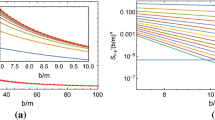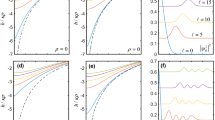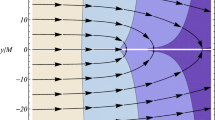Abstract
Experimental verification of the existence of gravimagnetic fields generated by currents of matter is important for a complete understanding and formulation of gravitational physics. Although the rotational (intrinsic) gravimagnetic field has been extensively studied and is now being measured by the Gravity Probe B, the extrinsic gravimagnetic field generated by the translational current of matter is less well studied. The present paper uses the post-Newtonian parametrized Einstein and light geodesics equations to show that the extrinsic gravimagnetic field generated by the translational current of matter can be measured by observing the relativistic time delay and/or light deflection caused by the moving mass. We prove that the extrinsic gravimagnetic field is generated by the relativistic effect of the aberration of the gravity force caused by the Lorentz transformation of the metric tensor and the Levi–Civita connection. We show that the Lorentz transformation of the gravity field variables is equivalent to the technique of the retarded Lienard–Wiechert gravitational potentials predicting that a light particle is deflected by gravitational field of a moving body from its retarded position so that both general-relativistic phenomena—the aberration and the retardation of gravity—are tightly connected and observing the aberration of gravity proves that gravity has a causal nature. We explain in this framework the 2002 deflection experiment of a quasar by Jupiter where the aberration of gravity from its orbital motion was measured with accuracy 20%. We describe a theory of VLBI experiment to measure the gravitational deflection of radio waves from a quasar by the Sun, as viewed by a moving observer from the geocentric frame, to improve the measurement accuracy of the aberration of gravity to a few percent.
Similar content being viewed by others
References
Ashby N. (2004). General relativity: Frame-dragging confirmed. Nature 31: 918
Ashby N. and Shahid-Saless B. (1990). Geodetic precession or dragging of inertial frames?. Phys. Rev. D 42: 1118
Bekaert X, Boulanger N. and Vázquez-Poritz J.F. (2002). Gravitational Lorentz Violations from M-Theory. J. High Energy Phys. 10: 53
Bertotti B., Iess L. and Tortora P. (2003). A test of general relativity using radio links with the Cassini spacecraft. Nature 425: 374
Bini D., Jantzen R.T. and Mashhoon B. (2001). Gravitomagnetism and relative observer clock effects. Class. Quant. Grav. 18: 653
Bini D., Cherubini C., Jantzen R.T. and Mashhoon B. (2003). Gravitomagnetism in the Kerr-Newman-Taub-NUT spacetime. Class. Quant. Grav. 20: 457
Bonilla M.Á.G. and Senovilla J.M.M. (1997). Very Simple Proof of the Causal Propagation of Gravity in Vacuum. Phys. Rev. Lett. 78: 783
Braginsky V.B., Caves C.M. and Thorne K.S. (1977). Laboratory experiments to test relativistic gravity. Phys. Rev D 15: 2047
Brumberg V.A. and Kopeikin S.M. (1990). Relativistic time scales in the solar system. Cel. Mech. Dyn. Astron. 48: 23
Camacho A. (2002). Coupling gravitomagnetism-spin and Berry’s phase. Gen. Rel. Grav. 34: 1963
Camacho A. (2002). Quantum Zeno effect and the detection of gravitomagnetism. In: Cianci, R., Collina, R., Francaviglia, M. and Fré, P. (eds) Recent developments in general relativity. 14th SIGRAV Conference on Gen. Rel. and Grav. Phys., pp 347–351. Springer, Milano
Carlip S. (2004). Model-dependence of Shapiro time delay and the ‘speed of gravity/speed of light’ controversy. Class. Quant. Grav. 21: 3803
Ciufolini I. (1986). Measurement of the Lense-Thirring drag on high-altitude, laser-ranged artificial satellites. Phys. Rev. Lett. 56: 278
Ciufolini, I.: Gravitomagnetism, Lense-Thirring Effect and De Sitter Precession. In: Pascual-Sanchez, J.F., Flori, L., San Miguel, A., Vicente, F. (eds.) Reference Frames and Gravitomagnetism. In: Proc. XXIII Spanish Relativity Meeting. World Scientific, Singapore, pp. 25–34 (2001)
Ciufolini I. and Pavlis E.C. (2004). A confirmation of the general relativistic prediction of the Lense-Thirring effect. Nature 431: 958
Ciufolini I. and Pavlis E. (2005). On the measurement of the Lense-Thirring effect using the nodes of the LAGEOS satellites, in reply to “On the reliability of the so-far performed tests for measuring the Lense-Thirring effect with the LAGEOS satellites” by L. Iorio. New Astron. 10: 636
Ciufolini I. and Ricci F. (2002). Time delay due to spin and gravitational lensing. Class. Quant. Grav. 19: 3863
Ciufolini I. and Ricci F. (2002). Time delay due to spin inside a rotating shell. Class. Quant. Grav. 19: 3875
Ciufolini I. and Wheeler J.A. (1995). Gravitation and Inertia. Princeton University Press, Princeton
Ciufolini I., Kopeikin S., Mashhoon B. and Ricci F. (2003). On the gravitomagnetic time delay. Phys. Lett. A 308: 101
Damour T. and Nordtvedt K. (1993). General relativity as a cosmological attractor of tensor-scalar theories. Phys. Rev. Lett. 70: 2217
Dittus H.L., Lämmerzahl C. and Turyshev S.G. (2007). Lasers, Clocks, and Drag-Free: Exploration of Relativistic Gravity in Space. Astrophysics and Space Science Library, vol. 349. Springer, Berlin
Einstein A. (1911). Über den Einfluß der Schwerkraft auf die Ausbreitung des Lichtes. Ann. Phys. 35: 898
Ellis G.F.R. and Uzan J.-P. (2005). c is the speed of light, isn’t it?. Am. J. Phys. 73: 240
Fock V. (1957). Three Lectures on Relativity Theory. Rev. Mod. Phys. 29: 325
Fock V. (1964). Theory of Space, Time and Gravitation 2nd edition. Pergaman Press, Macmillan Company
Fomalont E.B. and Kopeikin S.M. (2003). The Measurement of the Light Deflection from Jupiter: Experimental Results. Astrophys. J. 598: 704
Fomalont E. and Reid M. (2004). Microarcsecond astrometry using the SKA. New Astron. Rev. 48: 1473
Fomalont E.B. and Sramek R.A. (1976). Measurements of the solar gravitational deflection of radio waves in agreement with general relativity. Phys. Rev. Lett. 36: 1475
Frittelli S. (2003). Aberration by gravitational lenses in motion. Mon. Not. R. Astron. Soc. 344: L85
Futamase T. and Schutz B.F. (1983). Newtonian and post-Newtonian approximations are asymptotic to general relativity. Phys. Rev. D 28: 2363
Hannay J.H. (1985). Angle variable holonomy in adiabatic excursion of an integrable Hamiltonian. J. Phys. A Math. Gen. 18: 221
Harada W. and Fukushima T. (2003). Harmonic Decomposition of Time Ephemeris TE405. Astron. J. (USA) 126: 2557
Hawking S.W. and Ellis G.F.R. (1975). The Large Scale Structure of Space-Time. Cambridge University Press, Cambridge
Hellings, R.W.: Relativistic effects in astronomical timing measurements. Astron. J. (USA) 91, 650; Erratum in: Astron. J. (USA) 92, 1446 (1986)
IERS Conventions: Dennis D. McCarthy and Gérard Petit. (IERS Technical Note 32) Frankfurt am Main: Verlag des Bundesamts für Kartographie und Geodäsie, 2004. Chap. 11. (2003)
Iorio L. (2003). On Some Gravitational Spin-Spin Effect for Astronomical Bodies. Int. J. Mod. Phys. D 12: 35
Iorio L. (2005). On the reliability of the so-far performed tests for measuring the Lense Thirring effect with the LAGEOS satellites. New Astron. 10: 603
Iorio L., Ciufolini I., Pavlis E.C., Schiller S., Dittus H. and Lämmerzahl C. (2004). On the possibility of measuring the Lense Thirring effect with a LAGEOS-LAGEOS II-OPTIS mission. Class. Quant. Grav. 21: 2139
Jackson J.D. (1998). Classical Electrodynamics. Wiley, New York
Kaplan, G.H.: The IAU Resolutions on Astronomical Reference Systems, Time Scales, and Earth Rotation Models: Explanation and Implementation. USNO Circular 179 (http://www.aa.usno.navy.mil/publications/docs/Circular_179.html) (2005)
Klioner S.A. (2003). Light propagation in the gravitational field of moving bodies by means of Lorentz transformation I. Mass monopoles moving with constant velocities. Astron. Astrophys. 404: 783
Kopeikin S.M. (1990). Theory of Relativity in Observational Radio Astronomy. Sov. Astron. 34: 5
Kopeikin S.M. (2003). The post-Newtonian treatment of the VLBI experiment on September 8, 2002. Phys. Lett. A. 312: 147
Kopeikin S.M. (2004). The speed of gravity in general relativity and theoretical interpretation of the Jovian deflection experiment. Class. Quant. Grav. 21: 3251
Kopeikin S.M. (2005). Comment on ‘Model-dependence of Shapiro time delay and the “speed of gravity/speed of light” controversy’. Class. Quant. Grav. 22: 5181
Kopeikin S.M. (2006). Gravitomagnetism and the Speed of Gravity. Int. J. Mod. Phys. D 15: 305
Kopeikin S.M. (2001). Testing the Relativistic Effect of the Propagation of Gravity by Very Long Baseline Interferometry. Astrophys. J. Lett. 556: L1
Kopeikin S.M. and Fomalont E.B. (2006). Aberration and the Fundamental Speed of Gravity in the Jovian Deflection Experiment. Found. Phys. 36: 1244
Kopeikin S.M. and Fomalont E.B. (2006). On the speed of gravity and relativistic v/c corrections to the Shapiro time delay. Phys. Lett. A. 355: 163
Kopeikin S.M. and Makarov V.V. (2007). Gravitational bending of light by planetary multipoles and its measurement with microarcsecond astronomical interferometers. Phys. Rev. D 75: 062002
Kopeikin S.M. and Mashhoon B. (2002). Gravitomagnetic effects in the propagation of electromagnetic waves in variable gravitational fields of arbitrary-moving and spinning bodies. Phys. Rev D 65: 064025
Kopeikin S.M. and Ozernoy L.M. (1999). Post-Newtonian Theory for Precision Doppler Measurements of Binary Star Orbits. Astrophys. J. 523: 771
Kopeikin S.M. and Schäfer G. (1999). Lorentz covariant theory of light propagation in gravitational fields of arbitrary-moving bodies. Phys. Rev D 60: 124002
Kopeikin S. and Vlasov I. (2004). Parametrized post-Newtonian theory of reference frames, multipolar expansions and equations of motion in the N-body problem. Phys. Rep. 400: 209
Kopeikin S.M. and Wei-Tou Ni. (2007). Laser Ranging Delay in the Bi-Metric Theory of Gravity. In: Dittus, H.L., Lämmerzahl, C. and Turyshev, S.G. (eds) Lasers, Clocks, and Drag-Free: Exploration of Relativistic Gravity in Space. Astrophysics and Space Science Library, vol 249, pp 209–216. Springer, Berlin
Kovalevsky J. and Seidelmann P.K. (2004). Fundamentals of Astrometry. Cambridge University Press, Cambridge
Lämmerzahl, C., Neugebauer, G.: The Lense-Thirring Effect: From the Basic Notions to the Observed Effects; In: Gyros, Clocks, Interferometers... : Testing Relativistic Gravity in Space, Edited by C. Lämmerzahl, C.W.F. Everitt, F.W. Hehl, Lecture Notes in Physics, vol. 562, p. 31 Lecture Notes in Physics (2001)
Landau L.D. and Lifshitz E.M. (1971). The Classical Theory of Fields. Pergamon, Oxford
Lebach D.E., Corey B.E., Shapiro I.I., Ratner M.I., Webber J.C., Rogers A.E.E., Davis J.L. and Herring T.A. (1995). Measurement of the Solar Gravitational Deflection of Radio Waves Using Very-Long-Baseline Interferometry. Phys. Rev. Lett. 75: 1439
Mashhoon B. (1974). Can Einstein’s theory of gravitation be tested beyond the geometrical optics limit?. Nature 250: 316
Mashhoon B. (2001). Gravitoelectromagnetism. In: Pascual-Snchez, J.F., Floría, L., San Miguel, A. and Vicente, F. (eds) Reference Frames and Gravitomagnetism. Proc. XXIII Spanish Relativity Meeting, pp 121–132. World Scientific, Singapore
Mattingly, D.: Modern Tests of Lorentz Invariance. Living Rev. Relativity 8, (2005), 5. URL (cited on Sep 7, 2005): http://www.livingreviews.org/lrr-2005-5 (2004)
Mashhoon B., Hehl F.W. and Theiss D.S. (1984). On the gravitational effects of rotating masses - The Thirring-Lense Papers. Gen. Rel. Grav. 16: 711
Mashhoon B., McClune J.C. and Quevedo H. (1999). On the gravitoelectromagnetic stress-energy tensor. Class. Quant. Grav. 16: 1137
Mashhoon B., Iorio L. and Lichtenegger H. (2001). On the gravitomagnetic clock effect. Phys. Lett. A 292: 49
Maartens R., Mashhoon B. and Matravers D.R. (2002). Holonomy and gravitomagnetism. Class. Quant. Grav. 19: 195
Merloni A., Vietri M., Stella L. and Bini D. (1999). On gravitomagnetic precession around black holes. Mon. N. R. Astron. Soc. 304: 155
Misner C.W., Thorne K.S. and Wheeler J.A. (1973). Gravitation. Freeman, New York
Ni W.-T. (2005). Empirical Foundations of the Relativistic Gravity. Int. J. Mod. Phys. D 14: 901
Nordtvedt K. (1988). Gravitomagnetic interaction and laser ranging to Earth satellites. Phys. Rev. Lett. 61: 2647
O’Connell R.F. (2004). Proposed New Test of Spin Effects in General Relativity. Phys. Rev. Lett. 93: 081103
Pascual-Sánchez J.-F. (2004). Speed of Gravity and Gravitomagnetism. Int. J. Mod. Phys. 13: 2345
Penrose R. (1968). Structure of Space-Time. In: De Witt, C.M. and Wheeler, J.A. (eds) Battelle Recontres, pp 121–235. Benjamin, New York
Petrov A.Z. (1969). Einstein Spaces. Pergamon, New York
Pitjeva E.V. (2005). High-Precision Ephemerides of Planets?EPM and Determination of Some Astronomical Constants. Solar Syst. Res. 39: 176
Rafikov R.R. and Lai D. (2006). Effects of gravitational lensing and companion motion on the binary pulsar timing. Phys. Rev. D, vol. 73(6): 063003
Ruggiero M.L. and Tartaglia A. (2005). Post-Keplerian parameter to test gravitomagnetic effects in binary pulsar systems. Phys. Rev. D 72: 084030
Schilizzi, R.T.: The Square Kilometer Array. In: Proc. of the SPIE, vol. 5489, pp. 62–71
Schneider P., Ehlers J. and Falco E. (1992). Gravitational Lenses. Springer-Verlag, Berlin
Shapiro I.I. (1964). Fourth Test of General Relativity. Phys. Rev. Lett. 13: 789
Skrotskii G.V. (1957). On the influence of gravity on the light propagation. Doklady Akad. Nauk SSSR 114: 73
Soffel M., Klioner S.A., Petit G., Wolf P., Kopeikin S.M., Bretagnon P., Brumberg V.A., Capitaine N., Damour T., Fukushima T., Guinot B., Huang T.-Y., Lindegren L., Ma C., Nordtvedt K., Ries J.C., Seidelmann P.K., Vokrouhlick D., Will C.M. and Xu C. (2003). The IAU 2000 Resolutions for Astrometry, Celestial Mechanics, and Metrology in the Relativistic Framework: Explanatory Supplement. Astron. J. (USA) 126: 2687
Spallicci A. (2004). Satellite measurement of the Hannay angle. Nuov. Cim. B. 119: 1215
Spallicci A., Morbidelli A. and Metris G. (2005). The three-body problem and the Hannay angle. Nonlinearity 18: 45
Standish, E.M.: JPL planetary ephemeris DE410 Interoffice Memorandum 312.N-03-109 (2003)
Tartaglia A. (2000). Detection of the gravitomagnetic clock effect. Class. Quant. Grav. 17: 783
Tartaglia A. and Ruggiero M.L. (2004). Gravito-electromagnetism versus electromagnetism. Eur. J. Phys. 25: 203
Tartaglia A., Ruggiero M.L. and Nagar A. (2005). Time delay in binary systems. Phys. Rev. D 71: 023003
Urban, S.E., Bell, S., Kaplan, G.H., Hohenkerk, C.Y., Stewart, S.G., Bangert, J.A., Hilton, J.L.: The Astronomical Almanac 2006: Changes Resulting from IAU Resolutions. In: Bull. Am. Astron. Soc. Meeting 207, #25.05 (2005)
Van Flandern T. (1998). The speed of gravity - What the experiments say. Phys. Lett. A 250: 1
Van Flandern T. and Vigier J.P. (2002). Experimental Repeal of the Speed Limit for Gravitational, Electrodynamic and Quantum Field Interactions. Found. Phys 32: 1031
Wald R.M. (1984). General Relativity. The University of Chicago Press, Chicago
Wex N. and Kopeikin S.M. (1999). Frame Dragging and Other Precessional Effects in Black Hole Pulsar Binaries. Astrophys. J. 514: 388
Will C.M. (1993). Theory and Experiment in Gravitational Physics. Cambridge University Press, Cambridge
Will, C.M.: (2001) The Confrontation between General Relativity and Experiment. Living Rev. Relativity 4, 4. URL (cited on July 16, 2005): http://www.livingreviews.org/lrr-2001-4
Will C.M. (2003). Covariant calculation of general relativistic effects in an orbiting gyroscope experiment. Phys. Rev. D 67: 062003
Will C.M.: Has the speed of gravity been measured? (cited on July 14, 2007) http://www.wugrav.wustl.edu/people/CMW/SpeedofGravity.html (2005)
Wittman, D.: In: Courbin, F., Minniti, D. (eds.) Gravitational Lensing: An Astrophysical Tool. Springer-Verlag, Berlin, pp. 55–95 (2002)
Zakharov V.D. (1973). Gravitational Waves in Einstein’s Theory. Halsted Press, New York
Author information
Authors and Affiliations
Corresponding author
Rights and permissions
About this article
Cite this article
Kopeikin, S.M., Fomalont, E.B. Gravimagnetism, causality, and aberration of gravity in the gravitational light-ray deflection experiments. Gen Relativ Gravit 39, 1583–1624 (2007). https://doi.org/10.1007/s10714-007-0483-6
Received:
Accepted:
Published:
Issue Date:
DOI: https://doi.org/10.1007/s10714-007-0483-6




